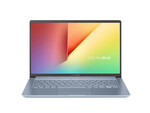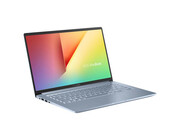Asus VivoBook 14 X403, i7-8565U
Specifications

Price comparison
Average of 1 scores (from 1 reviews)
Reviews for the Asus VivoBook 14 X403, i7-8565U
Source: India Today
 Archive.org version
Archive.org versionUnder Rs 60,000, most laptops mainly focus on performance but neglect the other parameters. The VivoBook 14 X403 is proof that it's not always the case. In the VivoBook 14 X403, Asus offers a finely crafted lightweight laptop that feels built to last and can take some rough abuse on a daily basis. The performance is flawless for a laptop of its class and the display is good enough for most of your regular needs. Most importantly, the 18-hour battery life on this thing makes it a dependable workhorse for those who don't like to sit close to a charging socket.
Single Review, online available, Short, Date: 09/04/2019
Rating: Total score: 80%
Comment
Intel UHD Graphics 620: Integrated GPU (GT2, 24 EUs) found on some Kaby-Lake-Refresh CPU models (15 W ULV series). Technically identical to the previous Kaby-Lake GPU called HD Graphics 620.
Modern games should be playable with these graphics cards at low settings and resolutions. Casual gamers may be happy with these cards.
» Further information can be found in our Comparison of Mobile Graphics Cards and the corresponding Benchmark List.
Intel Core i7: The Intel Core i7 for laptops is based on the LG1156 Core i5/i7 CPU for desktops. The base clock speed of the CPUs is relatively low, but because of a huge Turbo mode, the cores can dynamically overclock to up to 3.2 GHz (920XM). Therefore, the CPU can be as fast as high clocked dual-core CPUs (using single threaded applications) but still offer the advantage of 4 cores. Because of the large TDP of 45 W / 55 W, the CPU is only intended for large laptops.
i7-8565U: Whiskey Lake based low power quad-core processor (technically identical to Kaby Lake but produced in a further improved 14nm++ process). The four cores are clocked between 1.8 and 4.6 GHz (Turbo Boost) and support HyperThreading.» Further information can be found in our Comparison of Mobile Processsors.




